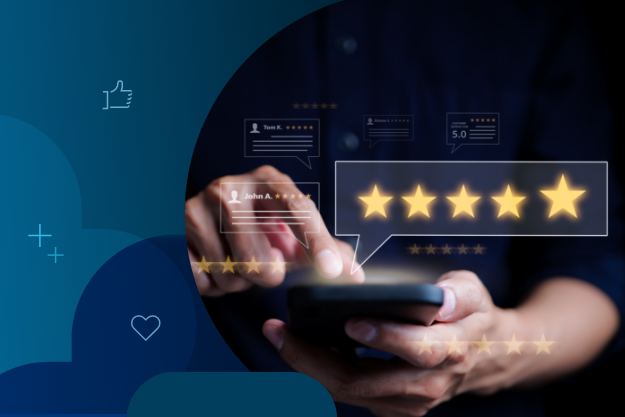Creating a personalized customer experience is one of the biggest trends for effective marketing in 2023. With the boom of eCommerce in recent years, companies now look to data more than ever to analyze every step of the customer journey.
Data is a powerful tool to predict customer behavior in an effort for online retailers to provide experiences that resonate with each customer who visits their store.
Personalization efforts such as product recommendations, relevant user-generated content (UGC), customized products, intelligent reviews, tailored product education, and seamless returns are just a few examples of the potential that data offers companies wishing to grow their online sales.
In this article, we'll go through the following:
What is a personalized online shopping experience?
The importance of personalization in today's eCommerce landscape
Collecting and analyzing customer data
Top five personalization efforts to impress customers
What is a personalized online shopping experience?
A personalized shopping experience refers to the ways customers can interact with your store that are tailored specifically to them.
This means that you, as a marketing expert, have created customer profiles for each of your customers so that you know their likes and preferences. This could be through an AI-driven recommendation tool that studies user behavior, for example. Their own personal shopping assistant.
This way, personalized recommendations can be made to each client when they visit your store, which increases the likelihood of more sales. A McKinsey research report showed that 80% of consumers are likely to purchase if they have received a personalized experience.
The importance of personalization in today's eCommerce landscape
Let's take a step back to realize the power of personalization.
Think about your local coffee shop. You're there most mornings, the people who work there all know your name, and they know your favorite beverage. Sometimes they even give you a free slice of cake as a way to say thanks for your loyalty.
What makes you stay loyal to them? Good coffee, yes - but also, the personalized customer experience.
In the eCommerce landscape, the need for personalization is paramount — especially since shopping online can feel less human and connective than in-person shopping. In fact, 71% percent of customers expect online stores to have some degree of personalization.

Sephora adds personalization to the brand's eCommerce experience by suggesting products a user has purchased before that might need replenishment.
This is no surprise given the rise of e-commerce in recent years, especially post-pandemic. We want things to be the same as before, but increasingly digital. Customers want the same experience in an online store that they get in physical stores and that is why personalization of online shopping experiences is so important.
Whether you're working on a budget or have the financial backing to develop your personalization strategy, leveraging and understanding quality data is essential to deliver personalized interactions to create a positive customer experience.
Several tools can analyze the data for you, but to develop useful personalization strategies, you need to have an understanding of how to interpret the data yourself.
Benefits of creating a personalized customer experience
Data has largely impacted our world for the better. In the eCommerce space, it creates a win-win situation for both companies and their customers. Customers receive more personalized experiences that expose them to products that they're interested in, and consequently, businesses end up making more money.
Besides improving customer experiences, there are a number of benefits that can be derived from a personalization strategy.
Increased customer loyalty
Reward your customers with special discounts on products you know they love (just like the slice of cake in the coffee shop), or even just showcase those products front and center when they visit your site. This turns everyday customers into loyal customers by showing them that you appreciate their support.
Offering customized products can also be a powerful way to increase customer loyalty, even if it's not with a special discount, as it allows businesses to create unique and personalized experiences for their customers, fostering a deeper emotional connection with the brand.
Improved decision-making
Data collected through customer information can help you to make informed decisions on future business activities such as marketing campaigns, new product development, sales strategies, and more. This information is essential down the line when choosing the direction of your next project.
Consistency throughout your brand
Whether customers are online or in-store, they receive a personalized shopping experience that will keep them coming back time and again. You begin to build confidence in your brand when you provide consistent omnichannel support, and subsequently increase purchase confidence.
Efficient customer support
Personalization post-checkout means that customers can seamlessly return or exchange items without any trouble. Allowing customers to navigate their own return or exchange lightens the load of your support team and prevents backlogs. This also gives customers the sense that you care about them finding the product that's right for them.
Using data to personalize your customers' online shopping experience can also reduce the workload for your customer support team.
Maximize your conversion rate
Personalized content gives browsers more confidence in their purchasing decisions, leading them to buy and effectively increase your conversion rate.
More than half of consumers say that if a company's website makes a good first impression on them, they're more likely to purchase from them multiple times. Another plus: loyal customers who continue to purchase from your brand can also result in a higher volume of persuasive, positive reviews.

Bob's Red Mill uses Pixlee TurnTo [now Emplifi] to create a review experience catered to both the buyers and the online shoppers reading those reviews. Subdimensions like dietary preferences and experience level help buyers convey their positive experience with the brand while helping site visitors find the reviews most relevant to them.
Collecting and analyzing customer data
Known as eCommerce analytics, collecting and analyzing customer data is the process of discovering, processing, interpreting, and communicating data that gives companies insight into individual customers and their purchasing behavior, ROI, and performance trends.
Data analytics is as much an art as it is a science when it comes to customer data. It's what brings the whole picture into view for marketers. Without it, there would be only numbers that can't be translated into actionable strategies.
Data analytics centralizes and manages the information marketers receive from multiple data sources. Marketers use data analytics to determine ROI on campaigns and to help them make future decisions to drive the direction of the business for increased sales and revenue.
There are a number of considerations when collecting data. The most important is the data quality. As a marketing expert, you must know how to collect the right data which will give you accurate results. Therefore, you need to collect data from your target audience to get a clear picture of their personal interactions with your brand.
In this light, you need to set up a solid data strategy with a systematic approach to collecting first-party data that will provide you with valuable insights.
In general, there are four types of customer data that you can collect for analysis:
1. Transactional data
The analysis of information on client spending patterns, preferred payment methods, the share of wallet, and other factors like product/service purchases, refunds, reservations, and more.
2. Product use data
Understanding product/service usage patterns (by examining log data, IoT data, requests from customer support service, etc.) aids organizations in improving a product/service portfolio and providing a better personalized experience. A PIM (product information management) solution can help to organize this so that a whole team can use the insights.
3. User web behavior data
Analysis of the pages that clients open, the time spent on site and on specific pages, their scrolling patterns and heatmaps, the locations where they click "buy" or "return," etc. It assists in identifying crucial stages in a customer's journey (where they become stuck, abandon, or convert), evaluating the effectiveness of certain pages, and customizing them as necessary.

With Pixlee TurnTo's in-platform analytics, brands can map specific dollar amounts in revenue to consumers' online behavior as it relates to UGC displayed on that brand's eCommerce website.
4. Social listening data
Analyzing customer opinions expressed in social media postings about a product or service reveals preferences, issues, and complaints that need to be fixed, as well as customer attitudes toward the product or service in question and the brand as a whole.
Also, better moderation of social media, fueled by the insights gained from analyzing customer feedback, will lead to more engagement and a brand image that is more customer-focused. You can even discover brand advocates and potential influencers as well as UGC to reuse in your marketing efforts by practicing social listening. Pixlee TurnTo's social listening features incorporate all of these strategies into one platform.
From this first-party data, you can extract another four types of analytics that you can convert into metrics to start making educated decisions. These include:
Descriptive customer analytics: Determining what has occurred or what is occurring right now in business by examining past and present customer-related data.
Diagnostic analytics: Identifying the source of a business issue by using methods like data mining and data discovery to analyze both internal and external customer-related data.
Predictive analytics: Employing machine learning and data mining techniques on past and current client data to make predictions and projections.
Prescriptive analytics: Advising the best course of action based on the predictive analytics outcome of possible future events.
There are a number of powerful customer analytics tools that can help you collect the right data and turn them into useful metrics so that you can add more value to each customer's experience with your brand and website.
A short list of recommended software tools:
Microsoft Power BI
Salesforce Interaction Studio
Google Analytics
Looker
This software should typically integrate with the following: CRM, an eCommerce system, a POS system, social media profiles, and digital marketing tools. Pixlee TurnTo's CRM [now Emplifi] covers UGC collection and curation, social listening, Ratings & Reviews collection and data analysis, influencer campaign management, and more.
Top 5 personalization efforts to impress customers
1. Shoppable UGC
It's no secret that Social UGC is an incredibly powerful marketing tool to persuade site visitors and showcase the loyal community your brand has built online (and in person). After all, consumers are more likely to trust the recommendations and experiences of people like them than content coming from your brand itself.
The best way to leverage UGC on your ecommerce website is to make it shoppable, whether through a homepage gallery, a landing page linked in your brand's Instagram bio, or product page carousels of customer media. With a UGC software like Pixlee TurnTo, you can import your product catalog into the platform, and easily tag products in photos and videos you collect from your fans on social media.
2. Personalized Product Recommendations
Shopping online should reflect what it's like in-store. Since your customers can't physically try on items, they need some form of guidance on the size and fit.
One way to do this is to create a short quiz that asks customers what kind of fit they're looking for, their general measurements, material, etc. Through this, you gather information on what your customers look for the most and you create uniquely relevant content for your customers.
Alternatively, you can also employ a digital shopping assistant (chatbot) that customers can go to for help with information on any item they may be interested in on your site.
3. Intelligent ratings and reviews
Online shopping has a high number of returns because customers often order the wrong product that isn't completely suited to them. Even after reading reviews from other customers, customers may not have a straightforward picture of the product because everyone is different.
Incorporating intelligent reviews will help to increase real-time personalization and reduce returns. Intelligent reviews filter reviews based on each customer's profile by showing information about each reviewer, such as body type, skin type, fit preference, use case, experience, and more elements specific to the product in question.

Pixlee TurnTo's Ratings & Reviews solution [now Emplifi Ratings & Reviews] allows brands to customize the different fields in review solicitation emails, and allows online shoppers to filter by these different elements. This way, customers can read reviews that are relevant to them during the buying process. This makes the customer feel as though the product they're buying is personal and unique to them.
4. Detailed product [ages
Some product categories require some form of education for customers before they make a purchase. For example, hair products, different types of wall paint, beauty products, golf clubs, and other products in a variety of industries.
The fact is that with these types of products, customers aren't sure what's ideal for them. The only thing they know is that they have a problem. Using your product detail pages, you need to show them that you have just the solution for them.
Along with a detailed description of your product, make sure ratings and reviews, as well as customer UGC are showcased prominently and easy for your shoppers to navigate. The more community-driven content on your PDPs, the easier it will be for shoppers to contextualize your product and envision how it will improve their lives.
5. Seamless returns portal
Return rates for online shopping continue to rise as shoppers usually order a number of items, try them on, and keep the items they like. This means that there is a high number of products coming back.
95% of respondents stated that following a pleasant return experience, they would shop at an online retailer again. You need to make sure that your website has an easy-to-use returns portal so that customers feel confident in purchasing from you, knowing that they can still decide to return a product without any hassle.
Wrapping up
In conclusion, using data to drive sales is essential. An effective personalization strategy will help you to find out more about your customers so that you can send the right message at the right time to each customer, inspiring them to take action to purchase a product from your ecommerce store.
Data collection from customers starts with identifying the right type of data you need to make valuable conclusions. You also need to incorporate customer analytics software with key features such as social listening, customer segmentation, customer behavior analytics, customer behavior prediction, and advanced analytics for customer relationship management.
Editor's Note: This article was originally published on pixlee.com. Any statistics or statements included in this article were current at the time of original publication.



























